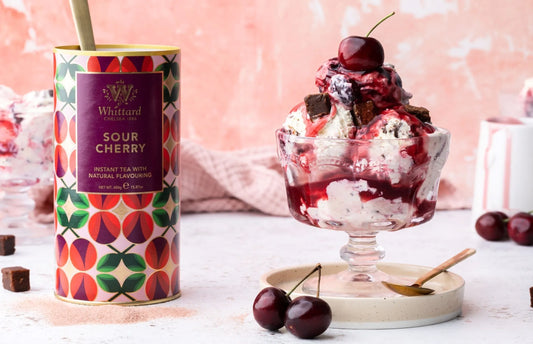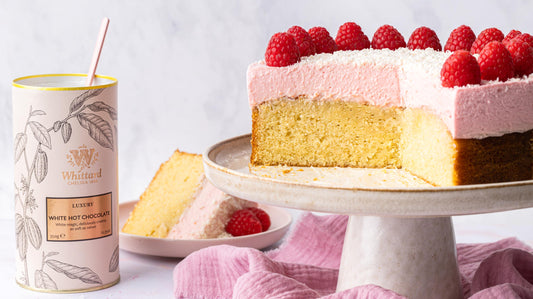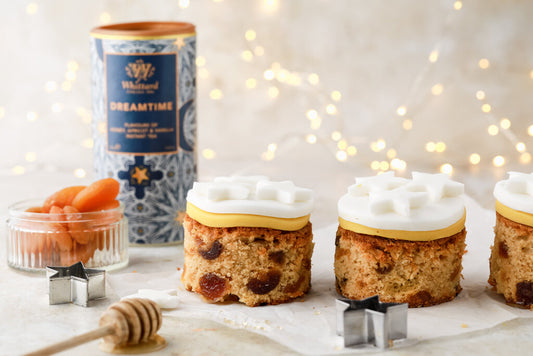A Guide to Tea Types
Black Tea
Black tea is fully oxidised, meaning that molecules in the tea react with oxygen to give the leaves a rich, robust flavour. Aside from that, black tea can vary hugely in taste: a delicate Darjeeling could hardly be more different from a sweet, malty Assam or a smoky Lapsang Souchong.
Many of our black teas are flavoured with fruit, spices or even flower petals, or infused with essential oils to complement the flavour of the tea. Their natural depth and richness makes them the perfect base for a wide range of different flavour combinations – why not get exploring?
How is it Produced?
Black teas are unique for being the only completely oxidised type of tea, giving them a distinctively full body and rich, malty taste.






Black tea contains around 37mg of caffeine per 100ml, which is a little more than oolong, green white and yellow tea. (It’s a good idea to bear in mind that this figure can vary depending on the specific batch of tea you drink, and the time, temperature and strength of your brew.)
Drinking Black Tea Whilst Pregnant
The NHS recommends that during pregnancy, caffeine consumption should be limited to 200mg per day. Always seek advice from your health care professional on food and drink consumption during pregnancy.
How Do You Brew Black Tea?
Black tea is more robust than other tea types, so don't hold back: we recommend brewing in freshly boiled water for 3–5 minutes and adding a splash of milk if you wish. An exception is First Flush Darjeeling, which is unusually delicate for black tea and should be brewed at around 96-100°C for no longer than 3 or 5 minutes.
 |
 |
 |
| 1 teaspoon | 96 - 100 degrees | 3 - 5 minutes |
“When I need a kick-start in the morning, I brew a mix of our Assam TGFOP1 and Chelsea Breakfast. Both are really lovely breakfast-style teas in their own right but the combination of thick, malty Assam and the bright, smooth Kenyan tea in the Chelsea Breakfast works really well... both on flavour and waking me up.”
Linda, Tea Buyer
Green Tea
The core difference between green and black tea is oxidation. While black tea is oxidised to change its flavour and appearance, green tea is heated to stop oxidation – preserving that fresh taste and green colour that makes it famous.
Many of the best green teas are found in Japan or China, whose different methods of steaming and firing to stop oxidation can have a big effect on the final cup. A fired green tea like Gunpowder Green tends to have a slightly nutty or smoky flavour, while steamed Japanese Gyokuro has a peas-in-a-pod freshness. We've got creative with many of our green teas – why not try a flavoured blend like Goji Açaí?
How is it Produced?
Unlike black tea, green tea is heated before oxidation can take place – preserving its delicate, refreshing taste.
Where Chinese and Japanese green teas differ is usually down to the heating stage. Chinese green tea tends to be fired, either by hand in a hot wok or rolled around several times in a large vat, achieving a slightly nutty or smoky flavour like our Gunpowder Green. Typically, Japanese tea is passed through hot steam and shaped to create needle-like leaves, resulting in a peas-in-a-pod freshness similar to that of our Gyokuro.

Green Tea and Caffeine
Both green tea and oolong contain around 31mg of caffeine per 100ml, which is a little less than black tea and a little more than white and yellow tea. (It’s a good idea to bear in mind that this figure can vary depending on the specific batch of tea you drink, and the time, temperature and strength of your brew.)
How Do You Brew Green Tea?
Green tea is more delicate than black tea, and should never be brewed with boiling water: the heat extracts tannins, giving your tea a bitter, astringent flavour. Use water off the boil (around 80°C) – leave the kettle after boiling for five minutes, then pour and infuse for 2–3 minutes. Oh, and we’d suggest giving milk a miss to enjoy the verdant flavour profile in all its glory.
 |
 |
 |
| 1 teaspoon | 80 degrees | 2 - 3 minutes |
“Tried green tea and been unconvinced? Sample a variety before coming to a conclusion! Sencha, Gunpowder Green and Dragon Well are all pure green teas, but vary in taste due to growing conditions and how they're processed and brewed. Each harvest of tea can taste different to the next.”
Linda, Tea Buyer
Fruit & Herbal Infusions
Our fruit and herbal infusions don't technically contain tea: instead, they're blended from fruit, herbs, spices and flowers. This means that all of our infusions – with the exception of our yerba mate infusions – are naturally caffeine-free.
There's an extraordinary range of flavours possible in a fruit and herbal infusion, from the natural sweetness of camomile flowers to bright, tart berries and hibiscus flowers. Yerba mate is a South American herb with a natural caffeine buzz; you'll find it in some of our more unusual blends, alongside inventions like Strawberry Mint, Liquorice Twist and Red Velvet.

Rooibos – a bush grown on the mountains of South Africa – has long been harvested to create a herbal infusion, with a smooth, treacle-toned taste. Seventeenth-century Dutch settlers soon developed a taste for the drink as a handy substitute for tea, but local bushmen had already passed down the secret of rooibos for generations.
The leaves undergo a similar process to black tea, being oxidised for a distinctive reddish-brown colour and malty flavour. Occasionally, rooibos is produced in a more similar manner to green tea: you'll find this unusual "green" rooibos in our Rainforest Rooibos blend.
How Do You Brew Rooibos Tea?
As rooibos doesn’t contain tea, there’s no tannic bitterness associated with over brewing – how you infuse is largely up to you! We recommend using double quantities (around 2tsp per cup) and freshly drawn and boiled water, then brewing for at least 3 minutes to get the most flavour possible out of your cup. If desired, add a splash of milk – although we’d recommend drinking our Rainforest Rooibos without to allow the fresh, fruity flavours to shine through.
 |
 |
 |
| 2 teaspoons | 100 degrees | At least 3 minutes |
Speciality Teas
Tea production is a centuries-old art, and throughout its long history tea growers have experimented with different techniques – from firing and steaming to more unusual methods like the steam oxidation used to produce yellow tea.
Partially oxidised and laboriously hand-rolled, oolong tea ranges from distinctive high-grown varieties to lighter, creamy oolongs.
How to Brew
Add one teaspoon (around 2g) of loose leaf tea per cup and freshly drawn and boiled water, left for a minute or two to cool to around 90°C. Brew for 3 minutes.
The least processed form of tea, white tea is simply left to dry for a light, subtly sweet and delicate flavour.
How to Brew
Add two teaspoons (around 4g) of loose leaf tea per cup and use water off the boil (around 80°C) – leave the kettle after boiling for five minutes, then pour and infuse for 2–3 minutes.
Famous for its unique processing and taste, puerh is fermented – sometimes for decades – to give it a rich, aromatic flavour.

How to Brew
Add one teaspoon (around 2g) of loose leaf tea per cup. Just cover the leaves with freshly boiled water, then immediately pour away the water: this "wakes up" the leaves for a fresher flavour. Then brew the puerh in freshly drawn water for up to 2 minutes.
Smooth, nutty yellow tea is the rarest type of tea in the world, produced only in minute quantities through a laborious process of piling and carefully monitoring the leaves.

How to Brew
Add two teaspoons (around 4g) per cup and always use freshly drawn and boiled water. Allow to brew for 3–5 minutes according to taste.






 PICKING
PICKING WITHERING
WITHERING HEATING
HEATING ROLLING
ROLLING









